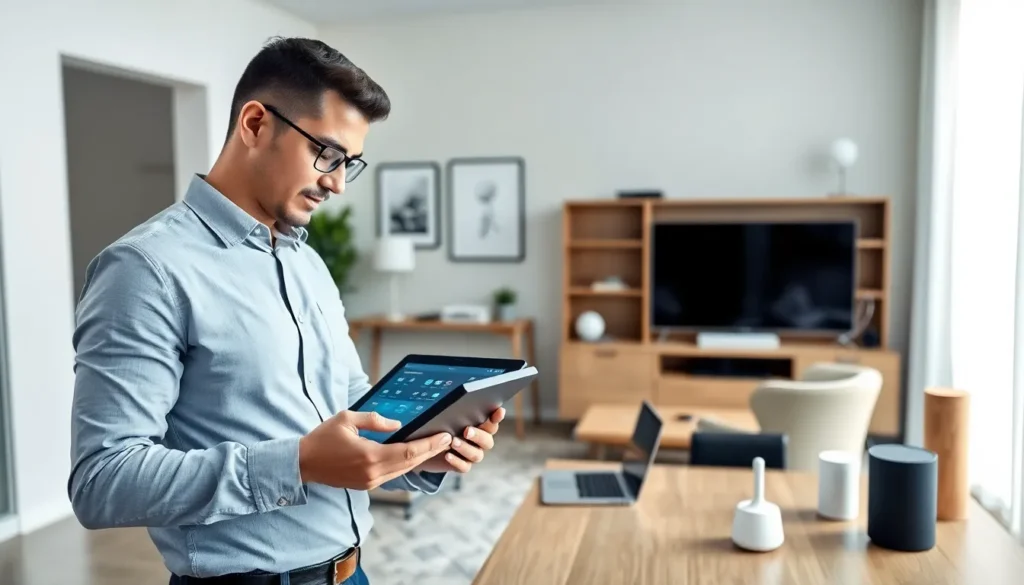Table of Contents
ToggleIn a world where your fridge might just be smarter than you, connected devices are revolutionizing daily life. From smart speakers that can play your favorite tunes to thermostats that learn your schedule, these gadgets are here to make life easier and a bit more fun. Imagine asking your coffee maker to brew your morning cup while you’re still in bed—now that’s what they call a wake-up call!
But with so many devices claiming to be “connected,” it can feel like navigating a tech jungle. Fear not! This article dives into the ultimate connected devices list, showcasing the must-haves that can transform your home into a smart haven. Get ready to embrace the future and discover which devices deserve a spot in your life—because who wouldn’t want a home that practically runs itself?
Overview Of Connected Devices
Connected devices play a significant role in modern households, creating a seamless blend of technology and daily living. Smart speakers like Amazon Echo and Google Nest serve as central hubs, allowing users to control various compatible devices with voice commands. Smart lighting systems enhance ambiance and save energy by enabling remote control and scheduling options.
Home security cameras, such as Ring and Arlo, offer real-time monitoring and alerts, helping homeowners ensure safety. Smart thermostats, including the Nest Learning Thermostat, adjust heating and cooling automatically based on user habits, promoting energy efficiency and comfort.
Fitness trackers, such as Fitbit and Apple Watch, monitor health metrics, facilitating a more active lifestyle. Smart appliances, including refrigerators and washing machines, streamline everyday tasks through connectivity and remote operation.
Connected home assistants simplify routine management, from grocery shopping reminders to controlling the entire smart home ecosystem. Streaming devices like Roku and Chromecast integrate with smart TVs, providing access to various entertainment options.
Each of these devices contributes to creating a connected environment that fosters convenience, efficiency, and enhanced quality of life. As technology continues to evolve, the integration of connected devices becomes increasingly vital in shaping modern living experiences.
Types Of Connected Devices
Connected devices encompass a variety of categories that enhance everyday living. These devices seamlessly integrate into personal and professional spaces.
Smart Home Devices
Smart home devices include products that create a cohesive, automated living environment. Smart speakers, like Amazon Echo and Google Nest, serve as the central control system for compatible gadgets. Smart lighting systems offer energy savings and customizable ambiance. Smart locks enhance home security by allowing remote access control. Each device contributes to a more convenient and efficient home.
Wearable Devices
Wearable devices consist of tech products designed for personal use and health management. Fitness trackers monitor daily activity levels, heart rate, and sleep patterns. Smartwatches extend functionality by providing notifications and health tracking features. These devices motivate users to lead active lifestyles while collecting valuable health data. Innovative features keep users connected and informed throughout the day.
Connected Health Devices
Connected health devices focus on empowering individuals to manage their well-being. Blood pressure monitors and glucose meters transmit data for real-time health assessment. Telehealth solutions facilitate remote medical consultations, enhancing accessibility to healthcare professionals. These technologies enable proactive health management and chronic condition monitoring. Integration with mobile applications provides users with valuable insights into their health.
Industrial IoT Devices
Industrial IoT devices cater to businesses by optimizing efficiency and productivity. Sensors monitor equipment performance and environmental conditions in real time. Automated systems streamline manufacturing processes, reducing operational costs. Connected machinery enables predictive maintenance, minimizing downtime and increasing output. These innovative solutions drive operational excellence across various industries.
Popular Brands And Their Offerings
Numerous brands offer connected devices that enhance daily living. Each company provides unique products designed to cater to various needs in smart homes, personal wellness, and industrial applications.
Brand A Devices
Amazon leads the smart device market with its Echo series, incorporating Alexa voice assistant technology. Smart speakers enable voice control for compatible devices throughout the home. The Ring security cameras enhance home safety by providing real-time alerts and video footage. Smart plugs allow users to manage energy consumption easily, adding flexibility and convenience to daily routines.
Brand B Devices
Google offers an extensive range of connected products, including the Nest family of devices. Nest Learning Thermostat adapts to user behavior, optimizing energy usage for maximum efficiency. Smart displays like the Nest Hub provide visual control for other devices, enhancing user interaction. Additionally, smart doorbells contribute to home security with features like video streaming and motion detection.
Brand C Devices
Apple integrates connected devices with its HomeKit ecosystem, emphasizing user experience and privacy. The HomePod speakers serve as smart home hubs, allowing users to control compatible devices seamlessly. Through the Apple Watch, users can monitor fitness activities and health metrics in real time. Smart light bulbs and smart plugs complete the range, providing compatibility with a variety of connected devices, ensuring a cohesive home automation experience.
Applications Of Connected Devices
Connected devices transform various sectors by enhancing efficiency and improving user experience. Below are key applications that demonstrate their significant impact.
Home Automation
Smart home technology simplifies everyday tasks through automation. Devices like smart lights adjust brightness based on user preferences, enhancing comfort. Voice-activated assistants manage multiple connected devices, allowing seamless control with simple commands. Users can schedule appliance operation, optimizing energy use and reducing bills. Security devices, such as smart cameras and doorbells, provide real-time surveillance and alerts for improved home safety. The integration of these devices fosters a smarter, more efficient living environment.
Health Monitoring
Connected health devices play a vital role in personal wellness. Fitness trackers monitor physical activity, heart rate, and sleep patterns, encouraging a healthier lifestyle. Smart scales provide weight and body composition data, helping users track progress over time. Devices like blood pressure monitors send readings directly to healthcare providers, enabling proactive health management. Telehealth solutions connect patients with medical professionals through secure platforms, facilitating remote consultations. Together, these tools empower individuals to take charge of their health.
Smart Cities
Connected devices contribute to the development of smart cities, enhancing urban living quality. Sensors monitor traffic patterns, enabling better transportation management and reduced congestion. Smart waste management systems optimize collection routes, decreasing operational costs. Energy-efficient streetlights adjust brightness based on environmental conditions, conserving energy. These technologies improve public safety through connected surveillance systems and emergency alerts. Collaboratively, connected devices create a more sustainable and efficient urban infrastructure.
Challenges In The Connected Devices Market
Connected devices face several challenges that impact their adoption and functionality. Security concerns and interoperability issues regularly come to the forefront of discussions in this growing market.
Security Concerns
Security remains a significant challenge for connected devices. Many users worry about data breaches and unauthorized access to personal information. Hackers frequently target vulnerable devices, leading to identity theft or privacy violations. Manufacturers must implement strong encryption and regular software updates to mitigate these risks. Consumers need assurance that their devices are secure before integrating them into their lives. Consequently, enhancing security features helps build trust with customers, ultimately promoting greater adoption of these technologies.
Interoperability Issues
Interoperability poses another critical challenge in the connected devices landscape. Devices from different manufacturers often struggle to communicate effectively, limiting seamless user experiences. Compatibility issues arise when devices utilize varying protocols or standards, which frustrates consumers seeking a cohesive smart home environment. Efforts to create universal standards across the industry are essential to address this problem. By promoting interoperability, manufacturers can ensure that connected devices work harmoniously, allowing users to enjoy the full benefits of smart technology in their daily routines.
Conclusion
Connected devices are transforming everyday life by enhancing convenience and efficiency. From smart speakers to health monitors, these technologies seamlessly integrate into daily routines, making tasks easier and more enjoyable. As users explore the possibilities of a smart home, they can experience the benefits of automation and improved security.
While challenges like security concerns and interoperability persist, the potential for connected devices to create a more streamlined and enjoyable living environment is undeniable. Embracing these innovations not only simplifies life at home but also promotes a healthier lifestyle and fosters a sense of community in smart cities. As the market continues to evolve, staying informed about the latest advancements will empower users to maximize the advantages of connected technology.





